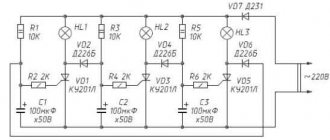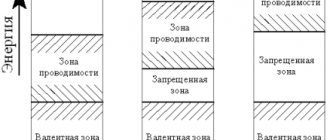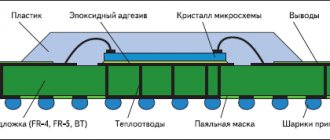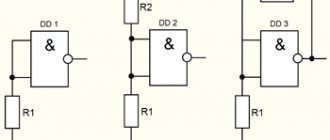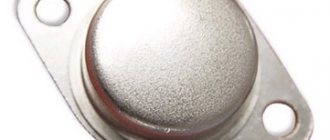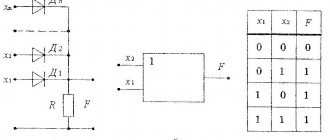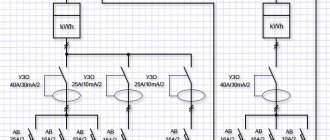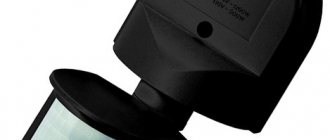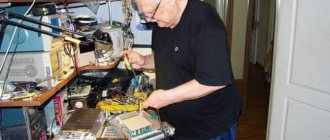Types of Electronic Circuits
In radio electronics, there are several types of circuits: circuit diagrams, wiring diagrams, block diagrams, voltage and resistance maps.
Schematic diagrams
Such an electrical diagram gives a complete picture of all the functional components of the circuit, the types of connections between them, and the operating principle of electrical equipment. Circuit diagrams are commonly used in distribution networks. They are divided into two types:
- Single-line. This drawing shows only power circuits.
- Full. If the electrical installation is simple, then all its elements can be displayed on one sheet. To describe equipment that contains several circuits (power, measuring, control), drawings are made for each unit and placed on different sheets.
Block diagrams
In radio electronics, a block is an independent part of an electronic device. A block is a general concept; it can include both a small and a significant number of parts. A block diagram (or block diagram) gives only a general concept of the structure of an electronic device. It does not display: the exact composition of the blocks, the number of ranges of their functioning, the schemes according to which they are assembled. In a block diagram, blocks are represented by squares or circles, and the connections between them are represented by one or two lines.
The directions of signal passage are indicated by arrows. The names of the blocks in full or abbreviated form can be applied directly to the diagram. The second option is to number the blocks and decipher these numbers in a table located in the margins of the drawing. Graphic images of blocks can display the main parts or plot their operation.
Assembly
Wiring diagrams are convenient for creating an electrical circuit yourself. They indicate the location of each circuit element, communication methods, and the laying of connecting wires. The designation of radioelements on such diagrams usually approaches their natural appearance.
Voltage and resistance map
A voltage map (diagram) is a drawing in which, next to the individual parts and their terminals, the voltage values characteristic of the normal operation of the device are indicated. Voltages are placed in the gaps of the arrows, showing in which places measurements need to be made. The resistance map indicates the resistance values characteristic of a working device and circuits.
Designation of radio components on electrical circuits
The designation on the diagrams of radio elements appears in the form of graphic figures.
For example, a resistor is depicted as an elongated rectangle with the letter “R” and a serial number next to it. “R15” means that the resistor in the circuit is the 15th in a row. The amount of power dissipated by the resistance is immediately prescribed. Changing the temperature of the soldering iron using a dimmer
Particular attention should be paid to the designation on the microcircuits. For example, you can consider the KR155LAZ microcircuit. The first letter "K" means a wide range of applications. If there is an “E”, then this is an export version. The second letter “P” determines the material and type of case. In this case it is plastic. A unit is a type of part, in the example a semiconductor chip. 55 – serial number of the series. The following letters express the AND-NOT logic.
Where to start reading diagrams
You need to start by reading circuit diagrams. For more effective learning, you need to combine the study of theory with practice. You must understand all symbols on the board. There is a lot of information on the Internet for this. It is a good idea to have reference material on hand in book format. In parallel with mastering the theory, you need to learn how to solder simple circuits.
How are radioelements connected in a circuit?
Boards are used to connect radio components. To make contact tracks, a special solution is used to etch copper foil on the dielectric layer of the printed circuit board. Excess foil is removed, leaving only the necessary tracks. The leads of the parts are soldered to their edges.
Additional Information. Lithium batteries, when heated by a soldering iron, can swell and collapse. To prevent this from happening, spot welding is used.
Letter designation of radioelements in the circuit
To decipher the letter designations of parts in the diagram, you need to use special tables approved by GOST. The first letter means the device, the second and third letters specify the specific type of radio component. For example, F means arrester or fuse. The full letters FV let you know that this is a fuse.
Graphic designation of radioelements in the circuit
The graphics of the circuits include a conventional two-dimensional designation of radioelements accepted throughout the world. For example, a resistor is a rectangle, a transistor is a circle in which the lines show the direction of the current, a choke is a stretched spring, etc.
A novice radio amateur should have a table of images of radio components at hand. Below are examples of tables of graphic symbols for radio components.
Table of graphic designations of radioelements on the diagram Table 2 Table 3 Table 4
For beginning radio amateurs, it is important to stock up on reference literature where you can find information about the purpose of a particular radio component and its characteristics. You can learn how to make your own printed circuit boards and how to solder circuits correctly using video lessons online.
Where to start reading diagrams?
In order to learn how to read circuits, first of all, we must study what a particular radio element looks like in a circuit. In principle, there is nothing complicated about this. The whole point is that if the Russian alphabet has 33 letters, then in order to learn the symbols of radio elements, you will have to try hard.
Until now, the whole world cannot agree on how to designate this or that radio element or device. Therefore, keep this in mind when you collect bourgeois schemes. In our article we will consider our Russian GOST version of the designation of radioelements
How are radioelements connected in a circuit?
So, it seems that we have decided on the task of this scheme. Straight lines are wires or printed conductors through which electric current will flow. Their task is to connect radioelements.
The point where three or more conductors connect is called a node. We can say that this is where the wiring is soldered:
If you look closely at the diagram, you can see the intersection of two conductors
Such intersection will often appear in diagrams. Remember once and for all: in this place the wires are not connected and they must be insulated from each other. In modern circuits, you can most often see this option, which already visually shows that there is no connection between them:
Here, it is as if one wire goes around the other from above, and they do not contact each other in any way.
If there was a connection between them, then we would see this picture:
Reading an Electrical Diagram
The diagram itself, on which the symbols are drawn, is called a schematic diagram. It not only shows how certain elements of the circuit are connected, but also explains how the entire device works, showing the principle of its operation. To achieve this result, it is important to correctly show the individual groups of elements and the connection between them.
In addition to the fundamental one, there are also installation ones. They are designed to accurately display each element in relation to each other. The arsenal of radioelements is huge. New ones are constantly being added. Nevertheless, the UGO in all diagrams is almost the same, but the letter code is significantly different. There are 2 types of standard:
- state, this standard may include several states;
- international, used almost all over the world.
But whatever standard is used, it must clearly show the designation of radio components on the diagram and their name. Depending on the functionality, UGO radio components can be simple or complex. For example, several conditional groups can be distinguished:
- power supplies;
- indicators, sensors;
- switches;
- semiconductor elements.
This list is incomplete and serves for illustrative purposes only. To make it easier to understand the symbols of radio components in the diagram, you need to know the principle of operation of these elements.
DESIGNATIONS OF RADIO COMPONENTS
When manufacturing radio-electronic devices, novice radio amateurs may have difficulty deciphering the symbols on the diagram of various elements. For this purpose, a small collection of the most common symbols of radio components has been compiled. It should be noted that only the foreign version of the designation is given here and differences are possible on domestic diagrams. But since most of the circuits and parts are of imported origin, this is completely justified. The resistor in the diagram is designated by the Latin letter “R”, the number is a conventional serial number according to the diagram. The resistor rectangle can indicate the resistor's power rating—the power it can dissipate over a long period of time without destruction. When current passes through the resistor, a certain power is dissipated, which leads to heating of the latter. Most foreign and modern domestic resistors are marked with colored stripes. Below is a table of color codes.The following is the structure and pinout indicating the purpose of the pins of popular imported digital microcircuits of the CD40xx series and LM operational amplifiers.
The most common designation system for semiconductor radio components is European. The main designation according to this system consists of five characters. Two letters and three numbers - for wide use. Three letters and two numbers - for special equipment. The letter following them indicates different parameters for devices of the same type.
The first letter is the material code:
A - germanium; B - silicon; C—gallium arsenide; R—cadmium sulfide.
The second letter is the purpose:
A - low-power diode; B - varicap; C - low-power low-frequency transistor; D - powerful low-frequency transistor; E - tunnel diode; F - low-power high-frequency transistor; G - several devices in one housing; N—magnetic diode; L - powerful high-frequency transistor; M - Hall sensor; P - photodiode, phototransistor; Q - LED; R - low-power regulating or switching device; S - low-power switching transistor; T - powerful regulating or switching device; U - powerful switching transistor; X - multiplying diode; Y - powerful rectifier diode; Z - zener diode.
Radio components forum
Forum for discussing the material DESIGNATIONS OF RADIO COMPONENTS RADIO
CONTROLLED TRACTOR FROM ORDINARY
Converting a toy ordinary tractor into a radio-controlled one - photographs of the process and the resulting result.
What are OLED, MiniLED and MicroLED TVs - a brief overview and comparison of technologies.
Several working circuits of electromagnetic Gauss Gun are given. The first part of the collection. ELECTROLYSER FOR HYDROGEN PRODUCTION
Review of a Chinese device for water electrolysis - photos, videos, description of work.
Domestic marking of microcircuits
Typical markings of domestic microcircuits are as follows: KR580VG80A.
The first letter indicates the specifics of the microcircuit:
K – orientation to the mass market; E – export version.
If the first letter is missing, the chip is highly specialized and configured for special tasks.
The second letter in the microcircuit marking indicates the type of case:
A – plastic (compact); B – absent (unpackaged microcircuit); E – DIP (metal); M – metal ceramics; N – metal ceramics (compact); P – DIP (plastic).
The number following the housing type characterizes whether the microcircuit belongs to one or another design and technical group.
1, 4, 8 – hybrid chips; 1, 5, 6, 7 – semiconductor chips; 3 – film version.
The next two digits indicate the series number.
The letters following the series indicate the functional purpose of the microcircuit.
A – shapers; B – delay modules; BM – passive electronic component; BR – active electronic component; B – computing module; G – pulse generator; EP – power source; I – digital electronic components; K – switching modules; H – bundles of components; P – various types of converters; P – storage modules; U – amplifiers; F – filters; X – multifunctional microcircuits.
The serial number of the series is followed by the development number (two-digit or single-digit).
The last symbol in the microcircuit marking indicates any features in its electrical characteristics.
Types of radio components - Elektroradiolom Prioksky company
The concept of “radio components” includes the entire group of electronic components that are used in a variety of household appliances. It will not be possible to list all the radio components, but we can highlight the main ones: resistors, diodes, microcircuits, transformers, relays, capacitors. Radio components are classified according to their mode of action in an electrical circuit:
- active - transistors, diodes and microcircuits. A transistor is a semiconductor triode that, using an input signal, is capable of controlling the voltage in an electrical circuit. Transistors replaced vacuum tubes. Not only are they much more compact in size, but they also consume less electricity. Diodes are semiconductors that conduct current in only one direction. They are made from silicon, have two leads and one electrical junction. Diodes are divided by type of purpose, junction size, design and frequency range. Microcircuits are electronic components in which transistors, diodes, resistors, capacitors and other elements are integrated into semiconductor substrates. Microcircuits process information received in the form of electrical signals. I classify them into analog, digital and analog-to-digital. They produce microcircuits with and without a housing.
- passive - resistors, transformers, capacitors and inductors. Resistors are redistributors of electric current between the components of the microcircuit. Resistors are classified according to their purpose, the nature of the change in resistance, the current-voltage characteristic, the method of protection and installation, as well as the manufacturing technology. Transformers are electromagnetic devices that convert one alternating current system to another without changing frequency. A transformer consists of one or more wire coils that are surrounded by magnetic flux. There are power transformers, isolation transformers, pulse transformers, matching transformers, as well as voltage and current transformers. Capacitors are devices for storing electric current and then releasing it. They are systems of several electrodes, which are separated from each other by dielectrics. Capacitors are classified according to the type of dielectric, which can be gaseous, liquid, solid inorganic and solid organic. Inductors are electronic components made of insulated conductor that are used to store energy, suppress noise, and limit alternating current.
ready to buy both active and passive radio components in new or used condition. We work with legal entities and individuals and guarantee fair prices at the Mitinsky market
Foreign marking of microcircuits (using the Pro Electron system)
In Europe and the West, there are several established labeling schemes for electronic components, each of which has minor differences in its field of application. But the basic principles remain common to all, and they are all listed in the classification adopted by the international Pro Electron association.
According to the Pro Electron classification, the marking of microcircuits consists of three alphabetic symbols followed by a numerical value.
The first letter indicates the method of signal conversion in the circuit:
T – analog conversion; S – digital conversion; U – mixed type transformation.
The second letter after the type of signal conversion does not have any fixed meaning (it is selected by the manufacturer). The exception is the letter “H”, which always denotes the hybrid operating principle of the chip.
In the case of digital electronic components, the first two letters indicate the features of the device:
FY – ESL line; GA – low-current TTL chips; GF – standard TTL; GJ – productive TTL; H – complementary microcircuits.
The third symbol in the microcircuit marking indicates the range of its operating temperatures:
A) not nominated; B) from 0 to +70 °C; C) from -55 to +125 °C; D) from -25 to +70 °C; E) from -25 to +85 °C; F) from -40 to +85 °C; G) from -55 to + 85 °C.
After the letter indicating the temperature range, there is a four-digit number - this is the serial number of the chip.
Following the serial number, the type of case is indicated in the microcircuit marking. This designation can be two-letter or one-letter.
The meaning of the first letter in two-letter markings:
C – cylindrical body; D – DIP housing (contacts are located in two rows along the edges of the microcircuit); E – DIP housing with heat dissipator; F – quadrangular flat (double-sided placement of contacts); G – quadrangular flat (four-sided placement of contacts); K – TO-3 body; M – multi-row body; Q – symmetrical arrangement of contacts along four edges; R – housing with a four-row arrangement of contacts and an external heat dissipator; S – contacts are placed in one row; T – housing with three-row arrangement of contacts.
We recommend reading: Flashlight from a cash register power supply
The meaning of the second letter in two-letter markings:
G – glass ceramics; M – metal; P – plastic; X – other materials.
If the serial number in the microcircuit marking is followed by one letter, it should be interpreted as follows:
C – cylindrical body; D – ceramic body; F – flat body; P – DIP plastic housing; Q – four-row arrangement of contacts; T – miniature plastic case; U – unpackaged integrated circuit.
The next two digits after the housing type are the serial number of the electronic component. The last number in the microcircuit marking is its operating temperature range. It should be interpreted as follows:
0) not nominated; 1) from 0 to +70 °C; 2) from -55 to +125 °C; 3) from -10 to +85 °C; 4) from +15 to +55 °C; 5) from -25 to +70 °C; 6) from -40 to + 85 °C.
We hope this information will help you understand the variety of markings, and you can easily select and buy microcircuits with the desired characteristics.
Marking and main parameters
The marking of varistors is different, since each manufacturer of these radio components has the right to install it independently. This is primarily due to its technical characteristics. For example, differences in voltages and required current levels for its operation.
You might be interested in How the Hall effect is used: principles of the phenomenon and methods of application
Among domestic ones, the most common is K275, and among imported ones - 7n471k, 14d471k, kl472m and ac472m. The most popular is a varistor, the marking of which is CNR (there are also hel, vdr, jvr). In addition, the alphanumeric index 14d471k is attached to it, and this type of designation is deciphered as follows:
- CNR - metal oxide type.
- 14 - device diameter equal to 14 mm.
- D is a disc-shaped radio component.
- 471 is the maximum voltage value for which it is designed.
- K is the permissible deviation of the classification voltage equal to 10%.
There are technical specifications required for application in the circuit. This is because different types of semiconductor resistance must be used to protect different circuit elements.
Their main characteristics:
- Classification voltage is the value of the potential difference, taken into account that a current of 1 mA flows through the varistor.
- The maximum value of the alternating voltage is the rms value at which it opens and, therefore, the value of its resistance decreases.
- The constant maximum voltage value at which the varistor opens in a DC circuit. As a rule, it is greater than the previous parameter for a current of variable amplitude.
- The permissible voltage (limitation voltage) is the value above which the element fails. Indicated for a specific current value.
- The maximum energy absorbed is measured in J (joules). This characteristic shows the amount of pulse energy that a varistor can dissipate and not fail.
- Response time (unit - nanoseconds, ns) - the value required to transition from one state to another, that is, a change in resistance value from a high value to a low value.
- Classification voltage error is a deviation from its nominal value in both directions, which is indicated in % (for imported models: K = 10%, L = 15%, M = 20% and P = 25%).
After describing the operating principle, marking features and main characteristics, the scope of application of varistors should be considered.
Letter abbreviations for radio electronics
| Letter abbreviation | Decoding the abbreviation |
| A.M. | amplitude modulation |
| AFC | automatic frequency adjustment |
| APCG | automatic local oscillator frequency adjustment |
| APChF | automatic frequency and phase adjustment |
| AGC | automatic gain control |
| ARYA | automatic brightness adjustment |
| AC | acoustic system |
| AFU | antenna-feeder device |
| ADC | analog-to-digital converter |
| frequency response | amplitude-frequency response |
| BGIMS | large hybrid integrated circuit |
| NOS | wireless remote control |
| BIS | large integrated circuit |
| BOS | signal processing unit |
| BP | power unit |
| BR | scanner |
| DBK | radio channel block |
| BS | information block |
| BTK | blocking transformer personnel |
| BTS | blocking transformer line |
| BOO | Control block |
| BC | chroma block |
| BCI | integrated color block (using microcircuits) |
| VD | video detector |
| VIM | time-pulse modulation |
| VU | video amplifier; input (output) device |
| HF | high frequency |
| G | heterodyne |
| GW | playback head |
| GHF | high frequency generator |
| GHF | hyper high frequency |
| GZ | start generator; recording head |
| GIR | heterodyne resonance indicator |
| GIS | hybrid integrated circuit |
| GKR | frame generator |
| GKCH | sweep generator |
| GMW | meter wave generator |
| GPA | smooth range generator |
| GO | envelope generator |
| HS | signal generator |
| GSR | line scan generator |
| gss | standard signal generator |
| yy | clock generator |
| GU | universal head |
| VCO | voltage controlled generator |
| D | detector |
| dv | long waves |
| dd | fractional detector |
| days | voltage divider |
| dm | power divider |
| DMV | decimeter waves |
| DU | remote control |
| DShPF | dynamic noise reduction filter |
| EASC | unified automated communication network |
| ESKD | unified system of design documentation |
| zg | audio frequency generator; master oscillator |
| zs | slowing system; sound signal; pickup |
| AF | audio frequency |
| AND | integrator |
| ICM | pulse code modulation |
| ICU | quasi-peak level meter |
| ims | integrated circuit |
| ini | linear distortion meter |
| inch | infra-low frequency |
| and he | reference voltage source |
| SP | power supply |
| ichh | frequency response meter |
| To | switch |
| KBV | traveling wave coefficient |
| HF | short waves |
| kWh | extremely high frequency |
| KZV | recording-playback channel |
| CMM | pulse code modulation |
| kk | frame deflection coils |
| km | coding matrix |
| cnc | extremely low frequency |
| efficiency | efficiency |
| KS | deflection system line coils |
| ksv | standing wave ratio |
| ksvn | voltage standing wave ratio |
| CT | check Point |
| KF | focusing coil |
| TWT | traveling wave lamp |
| lz | delay line |
| fishing | back wave lamp |
| LPD | avalanche diode |
| lppt | tube-semiconductor TV |
| m | modulator |
| M.A. | magnetic antenna |
| M.B. | meter waves |
| TIR | metal-insulator-semiconductor structure |
| MOP | metal-oxide-semiconductor structure |
| ms | chip |
| MU | microphone amplifier |
| neither | nonlinear distortion |
| LF | low frequency |
| ABOUT | common base (switching on a transistor according to a circuit with a common base) |
| VHF | very high frequency |
| oi | common source (turning on the transistor *according to a circuit with a common source) |
| OK | common collector (switching on a transistor according to a circuit with a common collector) |
| onch | very low frequency |
| oos | negative feedback |
| OS | deflection system |
| OU | operational amplifier |
| OE | common emitter (connecting a transistor according to a circuit with a common emitter) |
| Surfactant | surface acoustic waves |
| pds | two-speech set-top box |
| Remote control | remote control |
| pcn | code-voltage converter |
| pnc | voltage-to-code converter |
| PNC | converter voltage frequency |
| village | positive feedback |
| PPU | noise suppressor |
| pch | intermediate frequency; frequency converter |
| ptk | tv channel switch |
| PTS | full TV signal |
| Vocational school | industrial television installation |
| PU | preliminary effort |
| PUV | playback pre-amplifier |
| PUZ | recording pre-amplifier |
| PF | bandpass filter; piezo filter |
| ph | transfer characteristic |
| pcts | full color television signal |
| Radar | line linearity regulator; radar station |
| RP | memory register |
| RPCHG | manual adjustment of local oscillator frequency |
| RRS | line size control |
| PC | shift register; mixing regulator |
| RF | notch or stop filter |
| REA | radio-electronic equipment |
| SBDU | wireless remote control system |
| VLSI | ultra-large scale integrated circuit |
| NE | medium waves |
| SVP | touch program selection |
| Microwave | ultra high frequency |
| sg | signal generator |
| SDV | ultralong waves |
| SDU | dynamic light installation; remote control system |
| SK | channel selector |
| SLE | all-wave channel selector |
| sk-d | UHF channel selector |
| SK-M | meter wave channel selector |
| CM | mixer |
| ench | ultra-low frequency |
| JV | grid field signal |
| ss | clock signal |
| ssi | horizontal clock pulse |
| SU | selector amplifier |
| sch | average frequency |
| TV | tropospheric radio waves; TV |
| TVS | line output transformer |
| tvz | audio output channel transformer |
| tvk | output frame transformer |
| TIT | television test chart |
| TKE | temperature coefficient of capacitance |
| tka | temperature coefficient of inductance |
| tkmp | temperature coefficient of initial magnetic permeability |
| tkns | temperature coefficient of stabilization voltage |
| tks | temperature coefficient of resistance |
| ts | network transformer |
| shopping center | television center |
| tsp | color bar table |
| THAT | technical specifications |
| U | amplifier |
| UV | playback amplifier |
| UVS | video amplifier |
| UVH | sample-hold device |
| UHF | high frequency signal amplifier |
| UHF | UHF |
| UZ | recording amplifier |
| Ultrasound | audio amplifier |
| VHF | ultrashort waves |
| ULPT | unified tube-semiconductor TV |
| ULLTST | unified lamp-semiconductor color TV |
| ULT | unified tube TV |
| UMZCH | audio power amplifier |
| CNT | unified TV |
| ULF | low frequency signal amplifier |
| UNU | voltage controlled amplifier. |
| UPT | DC amplifier; unified semiconductor TV |
| HRC | intermediate frequency signal amplifier |
| UPCHZ | intermediate frequency signal amplifier? |
| UPCH | intermediate frequency image amplifier |
| URCH | radio frequency signal amplifier |
| US | interface device; comparison device |
| USHF | microwave signal amplifier |
| USS | horizontal sync amplifier |
| USU | universal touch device |
| UU | control device (node) |
| UE | accelerating (control) electrode |
| UEIT | universal electronic test chart |
| PLL | phase automatic frequency control |
| HPF | high pass filter |
| FD | phase detector; photodiode |
| FIM | pulse phase modulation |
| FM | phase modulation |
| LPF | low pass filter |
| FPF | intermediate frequency filter |
| FPCHZ | audio intermediate frequency filter |
| FPCH | image intermediate frequency filter |
| FSI | lumped selectivity filter |
| FSS | concentrated selection filter |
| FT | phototransistor |
| FCHH | phase-frequency response |
| DAC | digital-to-analog converter |
| Digital computer | digital computer |
| CMU | color and music installation |
| DH | central television |
| BH | frequency detector |
| CHIM | pulse frequency modulation |
| world championship | frequency modulation |
| shim | pulse width modulation |
| shs | noise signal |
| ev | electron-volt (e•V) |
| COMPUTER. | electronic computer |
| emf | electromotive force |
| ek | electronic switch |
| CRT | cathode-ray tube |
| AMY | electronic musical instrument |
| emos | electromechanical feedback |
| EMF | electromechanical filter |
| EPU | record player |
| Digital computer | electronic digital computer |
Other items
All radio components are connected to each other by conductors. In the diagram they are depicted as straight lines and drawn strictly horizontally and vertically. If the conductors have an electrical connection when crossing each other, then a dot is placed at this place. In Soviet and American diagrams, to show that the conductors are not connected, a semicircle is placed at the intersection.
To designate variable capacitors, an arrow is used; it crosses out the capacitor diagonally. In trimmers, a T-shaped sign is used instead of an arrow. Varicond - a capacitor that changes capacitance depending on the applied voltage, is drawn like an alternating one, but the arrow is replaced by a short straight line, next to which there is the letter u. The capacitance is shown with a number and a microFarad (microFarad) is placed next to it. If the capacity is smaller, the letter code is omitted.
Another element that no electrical circuit can do without is a resistor. Indicated in the diagram as a rectangle. To show that the resistor is variable, an arrow is drawn on top. It can be connected either to one of the pins, or be a separate pin. For trimmers, a sign in the form of the letter t is used. As a rule, its resistance is indicated next to the resistor.
Symbols in the form of dashes can be used to indicate the power of fixed resistors. A power of 0.05 W is indicated by three oblique, 0.125 W - two oblique, 0.25 W - one oblique, 0.5 W - one longitudinal. High power is shown in Roman numerals. Due to the diversity, it is impossible to describe all the designations of electronic components on the diagram. To identify a particular radio element, use reference books.
Radio components Wikipedia
Electronic components Identification of electronic components on diagrams Electronic components
Electronic components
(radio components) - components of electronic circuits.
Colloquial name for electronic components [ source not specified 711 days
] - “
radio components
” appeared from the fact that at the beginning of the 20th century, the first ubiquitous, and at the same time technically difficult for a non-specialist, electronic device was the radio.
Initially, the term “ radio components
” meant electronic components used for the production of radio receivers; then the common name spread to other radio-electronic components and devices that no longer have a direct connection with the radio.
Classification[ | ]
According to the type of current-voltage characteristic[ | ]
Based on the type of current-voltage characteristic (CVC) (or according to the method of action in an electrical circuit), two groups of electronic components (EC) are distinguished:
- passive
or
linear
EC - EC, the current-voltage characteristic of which is linear; - active
or
nonlinear
EC - EC, the current-voltage characteristic of which is nonlinear.
The following CIs are passive:
Features of reading circuits
In circuit diagrams, conductors (or tracks) are indicated by lines.
This designates conductors that intersect, but they do not have a common connection and are not electrically connected to each other.
And this is what they look like if there is a connection between them. The black dot is a node in the circuit. A node is a connection of several conductors or parts together. They are electrically connected to each other.
Common point
Beginner radio amateurs often have a question: what is this symbol on the diagram?
This is the common point (GND, ground). Previously, it was called the common wire. This is how a single power wire is designated. Usually this is a minus of nutrition. Previously, in the diagrams they could make the common wire and the power plus. In this case, the diagram without a common point would look like this:
A common point with unipolar power supply looks visually better and more compact than if you simply make a single line between them.
It is also called a common point because any other points on the diagrams can be measured relative to it. For example, place the multimeter probe on a common point, and with the second probe you can check any part of the circuit in the diagram.
Why can it be called ground (GND)? Previously, the chassis of the device body could be used as a common wire. This has caused confusion between grounding and earth. It is interpreted in the context of the schema. The circuit that was discussed above - the common point (ground) is simply a minus of the power supply. Another thing is bipolar current sources and grounding.
Bipolar power supply and common point
In a bipolar supply, the common point is the middle contact between plus and minus.
Grounding
An example of grounding would be a filter in computer power supplies.
From the capacitor filter, noise goes to the power supply housing. This is grounding. And from the power supply they must go into the outlet if you have a ground connection, otherwise the body of the power supply itself may be energized. The currents there are not large, they are not life-threatening. This is done to reduce impulse noise in the power supply and safety.
Sometimes in power supplies, instead of the housing, noise from the capacitor goes to a common point. It all depends on the design and circuitry. In this case, there will be more interference than with grounding.
In general, there are different grounding connections on the diagrams. For example, in digital technology, analog ground is separated from digital ground. so as not to disrupt the operating modes of the circuit. Pulse noise can affect the analog part of the circuit.
Application of devices
Varistors are used to protect electronic devices from surge voltages whose amplitude exceeds the rated power supply. Thanks to the use of a semiconductor resistor in power supplies, it becomes possible to avoid many breakdowns that can damage the electronics. Varistors are also widely used in ballast circuits, which are used in lighting elements.
Some voltage and current stabilizers also use specialized semiconductor resistors, and varistor-dischargers with voltages of more than 20 kV are used to stabilize power in power lines. It can also be connected to the wiring diagram (diagram 1), protecting it from overloads and unacceptable amplitude values of current and voltage. When the wiring is overloaded, it heats up, which can lead to a fire.
You might be interested in this: How to make a simple voltage regulator with your own hands
Scheme 1 - Connecting a varistor for a 220V network.
Low-voltage varistors operate in a voltage range from 3 V to 200 V with a current from 0.1 to 1 A. They are used in various equipment and are installed mainly at the input or output of the power source. Their response time is less than 25 ns, however, this value is not enough for some devices and in this case additional protection circuits are used.
However, the technology for their manufacture does not stand still, since it has created a radio element with a response time of less than 0.5 ns. This semiconductor resistor is made using SMD technology. Disc-type designs have a higher response time. Multilayer varistors (CN) are reliable protection against static electricity, which can damage various electronics. An example use is the production of mobile phones that are susceptible to static discharge. This type of varistors are also widely used in the field of computer technology, as well as in highly sensitive equipment.
How to learn to read circuit diagrams
There are really only a few ways. This is theory and practice. If you learn the designation of radio components, this does not mean that you have learned circuit design. It's like learning your ABC's, but without grammar and practice you won't learn the language.
Theory is circuit design, books, a description of the principle of operation of the circuit. Practice involves assembling devices, repairing and soldering.
For example, a simple amplifier circuit with one transistor.
Input X1 plus (left or right channel), X2 minus. The sound signal is sent to electrolytic capacitor C1. It protects transistor VT1 from short circuiting, since transistor VT1 is constantly open using a voltage divider across R1 and R2. The voltage divider sets the operating point at the base of transistor VT1, and the transistor does not distort the input signal. Resistor R3 and capacitor C2, which are connected to the emitter of transistor VT1, perform the function of thermal stabilization of the operating point as the temperature of the transistor increases. Electrolytic capacitor C3 accumulates and filters the supply voltage. The BF1 dynamic head serves as an audio signal output.
Is it possible to understand this only by learning the designations of radio components without circuit design and theory? Unlikely.
The situation is even more complicated with digital technology.
What kind of microcontroller is this, what functions does it perform, what firmware and what fuses are installed in it? And the second microcircuit, what amplifier is it? Without datasheets and a description of the circuit, it will not be possible to understand its operation.
Study circuit design, theory and practice. Simply learning the names of the parts will not help you understand the circuitry. The designation of radio components can be learned on its own with practice and accumulation of knowledge. It all depends on the chosen industry. Signalmen have one circuit design, mobile equipment repairmen have another. And those who deal with sound will not really understand electricians. As well as vice versa. To understand another industry, its circuitry and operating principles, you need to immerse yourself in it.
Circuit diagrams are a kind of language that has different dialects.
Therefore, one should not create illusions. Study circuit design and assemble circuits.
Recommended reading: Logic analyzer
Schematic diagrams help to assemble devices, and when studying the theory, to understand the operation of the device. Without knowledge and experience, a diagram is just a diagram.
Designations of radio components on circuit diagrams
UGO is a conditionally graphic image of a radio component on a diagram. Some UGOs differ from each other.
For example, in the USA the designation of resistors differs from the CIS and Europe.
Because of this, the perception of the scheme changes.
However, in appearance and in designations they are similar. Or, for example, transistors. Somewhere they are drawn with circles, and somewhere without. The size and angle of the arrows may vary. The table shows the UGO of domestic radio components.
UGOName
NPN bipolar transistor PNP bipolar transistor N-base unijunction transistor P-base unijunction transistor Relay winding Grounding Diode Diode bridge Schottky diode Double-node zener diode Bidirectional zener diode Reversing diode Zener diode Tunnel diode Varicap Inductor Inductor with adjustable core Inductor with core Classic transformer Winding Adjustable core Electrolytic capacitor Non-polar capacitor Reference capacitor Variable capacitor Trimmer capacitor On-off switch Reed switch Open switch Close switch N-channel FET FET p-channel Fast-acting fuse Time-lag fuse Fuse Breakdown fuse Thermal coil Refractory fuse Switch-fuse Arrester Arrester two-electrode Electrochemical spark gap Ion spark gap Horn spark gap Symmetrical spark gap Three-electrode spark gap Tubular spark gap Carbon spark gap Vacuum spark gap Valve spark gap Telephone socket Connector Connector Variable resistor Trimmer resistor Resistor 0.125 W resistor 0.25 W resistor 0.5 W resistor 1 W resistor Re resistor 2 W Resistor 5 W Reverse-conducting dinistor Reverse-turn-on dynistor Diode symmetrical thyristor Tetrode thyristor Cathode-controlled thyristor Anode-controlled thyristor Cathode-controlled thyristor Triode symmetrical thyristor Anode-controlled turn-off thyristor Cathode-controlled thyristor Diode optocoupler Photodiode Photothyristor Phototransistor Resistive optocoupler LED Thyristor optocoupler These are not all the details. And there is no particular point in cramming them. Such tables are useful in the form of a reference book. You can identify what kind of part is shown on the diagram while studying it or assembling the device.
Radio components are... What are Radio components?
Radio components Designation of radio components on diagrams
Radio components
- colloquial name
for electronic components
used for the manufacture of digital and analog electronics devices (instruments).
The appearance of the name was influenced by the historical fact that at the beginning of the 20th century, the first widespread, and at the same time technically difficult for a non-specialist, electronic device was the radio. Originally the term
radio components meant electronic components used for the production of radio receivers; then the everyday name, with a certain amount of irony, spread to other radio-electronic components and devices that no longer have a direct connection with the radio.
Classification
Electronic components are divided, according to the method of action in the electrical circuit, into active
and
passive
.
Passive
Basic elements found in almost all electronic circuits of radio-electronic equipment ( REA)
), are:
Using electromagnetic induction
Based on electromagnets:
In addition, to create a circuit, all kinds of connectors and circuit breakers - keys - are used; for protection against overvoltage and short circuit - fuses; for human perception of the signal - light bulbs and speakers (
dynamic loudspeaker head), for signal formation - microphone and video camera; To receive an analog signal transmitted over the air, the receiver needs an Antenna, and to operate outside the electrical network, batteries.
Active
Vacuum devices
With the development of electronics, vacuum electronic devices appeared:
Semiconductor devices
Subsequently, semiconductor devices became widespread:
and more complex complexes based on them - integrated circuits
By installation method
Technologically, according to the installation method, radio components can be divided into:
see also
Links
Ratings of radio components
In general, there are disagreements in this regard. According to GOST at the moment, the nominal values of parts are not indicated on circuit diagrams. This is done in order not to clutter the diagram with information.
The circuit diagram is accompanied by a list of parts, wiring and structural diagrams, as well as a printed circuit board.
There is another generally accepted standard. The diagrams indicate the ratings of some parts and their operating voltages.
For example, in this circuit there are two resistors.
By default, resistance without a prefix is written only as a number. R2 has a resistance of 220 Ohms. And R3 has a letter after the number. The resistance of this resistor reads 2.2k ohms (2,200 ohms).
Consider two capacitors in the diagram.
In this case, C5 is a non-polar capacitor with a capacitance of 0.01 µF. Microfarads can be designated either uF or uF. And capacitor C6 is polar and electrolytic. This is indicated by the plus sign near the UGO. Capacitance C6 is 470 μF. The rated operating voltage is indicated in volts. Here for C6 it is 16 V.
Nanofarads are denoted as nF.
If there is no microfarad (uF) or nanofarad (nF) prefix on the circuit, then the capacitance of this capacitor is measured in picofarads (pF, pF). This condition is not common, so carefully study the diagram you are about to read or assemble. There are few capacitances in farads (F), so µF, nF and pF are used.
Main types of SMD components
Let's look at the main SMD elements used in our modern devices. Resistors, capacitors, low-value inductors, fuses, diodes and other components look like ordinary small rectangles, or rather, parallelepipeds))
On boards without a circuit, it is impossible to know whether it is a resistor, a capacitor, or even a coil. The Chinese mark as they please. On large SMD elements, they still put a code or numbers to determine their identity and value. In the photo below these elements are marked in a red rectangle. Without a diagram, it is impossible to say what type of radio elements they belong to, as well as their rating.
The standard sizes of SMD components may be different. Here is a description of the standard sizes for resistors and capacitors. Here, for example, is a yellow rectangular SMD capacitor. They are also called tantalum or simply tantalum:
And this is what SMD transistors look like:
There are also these types of SMD transistors:
Inductors, which have a high rating, in SMD version look like this:
And of course, how can we live without microcircuits in our age of microelectronics! There are many SMD types of chip packages, but I divide them mainly into two groups:
1) Microcircuits in which the pins are parallel to the printed circuit board and are located on both sides or along the perimeter.
2) Microcircuits in which the pins are located under the microcircuit itself. This is a special class of microcircuits called BGA (from the English Ball grid array - an array of balls). The terminals of such microcircuits are simple solder balls of the same size.
The photo below shows a BGA chip and its reverse side, consisting of ball pins.
BGA chips are convenient for manufacturers because they greatly save space on the printed circuit board, because there can be thousands of such balls under any BGA chip. This makes life much easier for manufacturers, but does not make life any easier for repairmen.
